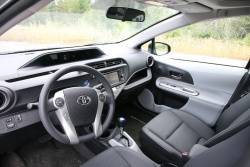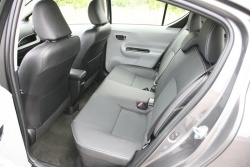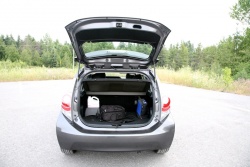   2012 Toyota Prius C. Click image to enlarge |
As in any Prius, the C’s powertrain is fantastic: not in terms of speed, because this car is definitely not fast, but the engine and electric motor work together very smoothly to move the car at the rather modest rate of acceleration they are capable of. With enough charge in the battery, the car will move away from stoplights on electricity alone, and once underway, transitioning from hybrid power to pure electricity is as easy as backing off the throttle until the “EV” light in the instrument cluster blinks on.
That leads me to one of my chief complaints about this car: getting the most out of a hybrid requires more awareness of what the car’s mechanicals are up to than most drivers might be used to. The instrument cluster helps in that regard, giving the interested driver clues as to when the gas engine is running, and how much throttle can be dialed in while keeping the car in electric-only mode. My ‘first-world problem’ is that I don’t want to have to keep one eye on the gauge cluster when I’m keen on running the car on ohms instead of octane. This isn’t a Prius-centric complaint, either; the Ford Fusion – another well-engineered hybrid – provides the same kind of visual feedback via its instrument panel.
Toyota will tell you that the Prius’ central dash-top display reduces the distance the driver’s eyes need to stray from the view of the road, but realistically, the difference between that design and a more traditional gauge placement is academic. Anything that distracts the driver away from the road is bad news. There are alternatives: how about a head-up display, or the force-feedback pedal that Nissan and Infiniti use? The latter could be used in a car like the Prius to provide electronic feedback in the throttle pedal to indicate at which point the gas engine needs to fire up. That might get annoying to many drivers, but those fixated on fuel economy would have a much safer alternative than continually glancing at the Prius’ sliding power display.
Another negative both James and I noticed is this car’s unimpressive turning radius. Even now, I continue to be surprised at how much space I need to make a turn into a parking spot, quite the opposite of what I would expect from such a little car.
The synthetic leather seats bundled into the premium package are pretty awful, feeling more like the vinyl upholstery on the crummy kitchen chairs my parents had when I was a kid. The only good thing I can say about it is that it provides some lateral grip to keep your butt where it belongs if you take a corner with a bit of speed. Otherwise, though, it doesn’t feel or look like “premium,” and what’s worse, it gets really, really hot in the sun – more so than black leather.
Our opinions of this car are mixed at best, so far, but we’ve got a ways to go to discover all that we like and dislike, so read our next update, coming in a few weeks.
Pricing: 2012 Toyota Prius C
Base price: $20,950
Options: $4,390 (Premium Technology Package)
Freight: $1,560
A/C tax: $100
Price as tested: $27,000











